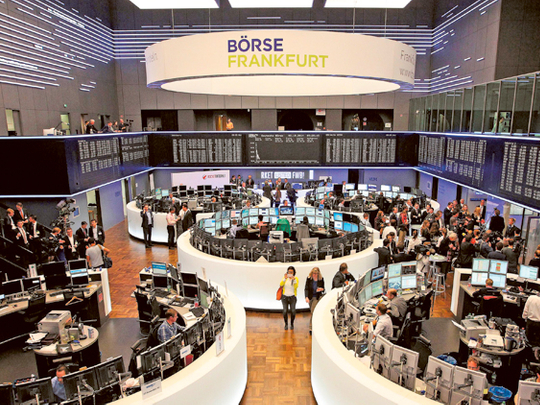
London: A rally in world stocks sparked by Federal Reserve assurances it will not rush US rate hikes ran out of steam on Thursday as the dollar remained in the grip of its worst run in months.
The Fed’s message had helped settle nerves about fragile global economic growth and revived risk appetite. But there were signs as US trading approached that — with third quarter earnings also getting into gear amid concerns that recent dollar strength may have weighed on US exporters — the effect was starting to wear off.
Wall Street was expected to open lower, beaten-down oil and commodity prices were sliding again and bond yields in much of Europe, which have plunged during years of cheap funding from the Fed and the world’s other major central banks, hit record lows.
Minutes of the Fed’s Sept. 16-17 meeting published late on Wednesday showed officials were wary about the dual threats of a stronger dollar and recent wobbles in the world economy as they seek an eventual exit from record low rates.
After big gains on Wall Street and in Asian stocks overnight, European shares initially followed suit. But Britain’s FTSE 100, Germany’s DAX and France’s CAC 40 had all slipped back into the red as US trading approached.
“It (the Fed’s message) has stabilised risk appetite and it was well needed following the macroeconomic disappointments we have had recently,” said Hans Peterson, global head of asset allocation at SEB investment management. “It is a burning issue, the pace of US interest rate rises. They will tighten of course, but it will probably be very slow.”
News that German exports slumped 5.8 per cent in August — adding to signs that Europe’s largest economy is faltering — tapped in to the recent cautious mood.
German Bunds Spanish and Belgian government bond yields all hit record lows in a broad-based euro zone debt rally, though emerging markets, which are seen as risky but have been pressured by US rate rise concerns, saw a rebound.
RATE DEBATE
Wall Street’s S&P500, which had seen its biggest rise in year after the Fed’s minutes, was expected to shed around 0.3-0.4 per cent when trading resumed, despite healthy-looking unemployment claims data.
With third quarter earnings under way, traders were digesting numbers from PepsiCo and Family Dollar.
Analysts fret the roughly 9 per cent rise in dollar in the last five months, while potentially good for consumer firms, will be starting to sting for those that sell internationally.
“The currency impact on US earnings this season is going to be quite huge,” said Lewis Grant, a global equities fund manager at Hermes in London. “Looking at some of these forecasts for the full year will be very interesting.”
US interest rate futures {0#FF:} {0#ED:} had reacted swiftly to the minutes, with June 2015 Eurodollar interest rate futures hitting a contract high as traders scaled back expectations the Fed will raise rates by the middle of 2015.
The rate-sensitive two-year US Treasury note yield
hit a seven-week low of 0.4244 per cent in Europe. The 30-year bond yield dropped to a 17-month low of 3.0306 per cent.
DOLLAR DIPS
In the currency market, where the dollar had gained sharply over the past three months on the perception that higher US rates down the road will attract more funds, investors rushed out of dollar-buying positions.
The dollar index against a basket of six major currencies
slipped to 84.937, its lowest in about two weeks and well off a four-year high of 86.746 hit on Friday.
For the euro it meant a fourth day of upward momentum. It hovered near a session high of $1.2765 as US trading gathered momentum, while the dollar was worth 107.85 yen.
Russia’s rouble also steadied after what analysts calculate has been a $3.5 billion intervention spree by its central bank over the last week. Sterling, meanwhile, was barely budged after the Bank of England kept rates steady.
In commodities, US crude oil prices rebounded from a 1-1/2-year low hit overnight to $87.20 per barrel, while Brent crude, the European benchmark, inched off Wednesday’s two-year low to $90.88. A weaker dollar makes dollar-denominated assets cheaper for holders of other currencies.
Gold, which also tends to benefit from loose monetary policy, climbed to its highest in about two weeks, with spot gold rising about 0.4 per cent to $1,229 an ounce.











